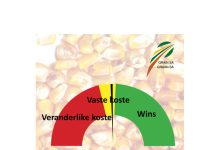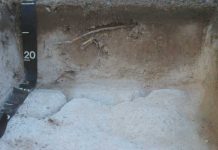Soil is the most fundamental resource for the farmer, without which food and natural fibre cannot be produced. This article forms part of a series to highlight this resource. In this article, soil acidity and the management thereof is discussed.
Introduction
The soil’s acidity level (pH) is argu¬ably the most important chemical parameter in the measurement of the soil’s general “chemical health”. It significantly influences plant growth and the uptake of a variety of plant nutrients. The maintenance of a favourable soil pH is therefore of vital importance for the land user and has an intrinsic influence on the sus¬tainable utilisation of the soil.
What is pH?
An important property of the soil solution is the soil reaction – in other words whether the soil is acid, neutral or alkaline. Acid refers to an excess of H+ ions compared to OH– ions and in the same context alkaline refers to an excess of OH– ions compared to H+ in the soil solution. With a neutral solution, there are equal quantities of H+ and OH– ions. The soil reaction is measured as pH. It is the negative logarithm of the hydrogen ion concen¬tration [H+] expressed as “mole per litre” (pH = -log [H+] and it ranges from 0 to 14. A pH of 1 is strongly acidic and a pH of 14 is strongly alka¬line, with a pH of 7 being neutral.
For example: A pH of 6 implies an H+ ion concentration 10-6 mole litre-1 (0,000 001 mole litre-1) and an OH– ion concentration of 10-8 mole litre-1 (0,000 000 01 mole litre-1) (the difference between the pH value and 14 is the OH– concentration). There is thus 10×10=100 times more H+ than OH– ions in the soil solution and the soil is therefore acidic.
At a pH of 7 there are 10-7 mole litre-1 H+ and 10-7 OH– ions and the soil is neutral. At a pH of 9 there are fewer H+ ions (10-9 mole litre-1) than OH– ions (10-5 mole litre-1) and the soil is alkaline. It must be remembered that the pH units are given in a log scale: One pH difference therefore indicates a 10-fold difference on concentration. A solution with a pH of 4 therefore has a 1 000 times more H+ ions than a solution with pH of 7.
The relationship of soil acidity versus climate and topography
Acid soils are generally found in high rainfall areas where basic cations are leached out of the soil, with an accompanying increase in the H+ ion concentration and therefore a decrease in soil fertility. Alkaline soils are normally associated with low rain¬fall areas and relative accumulation of basic cations in the soil, in other words limited leaching. Deep sandy soils on high-lying parts of the land¬scape which drain well are therefore more inclined towards acidification than poorly drained soils in low-lying parts of the landscape where basic cations accumulate.
Changes in soil pH
As a result of acidification, the adsorbed hydrogen and aluminium increases on the soil exchange com-plex. Alkalisation is the increase in the adsorbed basic cations (calcium, magnesium, potassium and sodium).
Soil acidification is the result of:
- H+ ions that are released into the soil solution by the dissociation of organic acids and inorganic acids that are released during the decomposition of organic material.
- Inorganic acids such as sulphuric acid and nitric acid can end up in the soil together with fertilizer or through air pollution (acid rain).
- Exchangeable basic cations such as Ca2+ and Mg2+ that are removed from the soil under high rainfall and leaching conditions, so that H+ and Al3+ ions are adsorbed in their place on the exchange complex.
- Under conditions of high soil acidity the silicate clays weather and Al3+ ions are released from the octahedral layers of the clay. The Al3+ ions are hydrolysed in the soil solution to Al hydroxide, which releases H+ ions and consequently the soil is acidified.
| Al3+ | + H2O | → | Al(OH)2+ + H+ |
| Al(OH)2+ | + H2O | → | Al(OH)2+ + H+ |
| Al(OH)2+ | + H2O | → | Al(OH)3+ H+ |
| Al(OH)3 | + H2O | → | Al(OH)4- + H+ |
- Dissolved salts of, amongst others, fertilisation materials provide basic cations and will, in acidic soil, exchange some of the Al3+ ions on the clay complex, which will cause the pH of the soil solution to decrease.
- Growing plant roots release carbon dioxide (CO2), which react with water to form carbonic acid, which dissolves in ground water to release H+.
Because the H+ ion concentration in the soil solution increases, the balance between the adsorbed H+ on the clay complex and H+ in the soil solution is disturbed. This disturbed balance results in H+ ions in the soil solution replacing the basic cations (Ca2+ and Mg2+) on the clay complex. The basic cations that are displaced by the H+ end up in the soil solution and are removed by plant absorption or leaching. This vicious circle can only be broken by increasing the con¬centration of basic cations in the soil solution, for example, by adding lime.
Neutralisation of soil acidity
The most common materials that are used to combat soil acidification, are calcium oxide (CaO), calcium hydroxide [Ca(OH)2] and calcitic lime [calcium carbonate Ca(CO3)] or dolomitic lime [calcium/magnesium carbonate [CaMg(CO3)]. When lime is mixed with the soil it dissosiates and increases the Ca2+ and / or Mg2+ ion concentration of the soil solution. The Ca2+ and Mg2+ ions displace the H+ ions on the exchange complex to form H2O and CO2.

Alkalisation takes place when ad¬sorbed Al3+ and H+ ions are displaced by basic cations such as Ca2+, Mg2+, K+ and Na+ on the exchange complex. As a result, the H+ ion concentration in the soil solution will decrease and the OH- concentration will increase, which will bring about an increase in the pH. A high basic cation con¬centration in the soil solution can be the consequence of (i) weathering of minerals, (ii) inflow of salts from areas higher up in the landscape, (iii) addition of salts via irri¬gation water, and (iv) limited leaching as a result of a low rainfall.
The quantity of bases or acids that are needed to bring about a change of one pH unit, will differ amongst soils. The resistance offered by a soil against a change in pH, is called the buffer capacity. A soil that is well buffered will need more reagents to change the pH than a soil that is poorly buffered. The pH of a soil with a good buffer capacity will, under natu¬ral circumstances, remain constant, while the pH of poorly buffered soils will easily acidify. A general rule is that the higher the clay percentage of a soil and its humus content and therefore the cation exchange capacity, the bet¬ter it is buffered. On the other hand, a sandy soil with a low humus content has a low buffer capacity and acidifies more easily, but it will react quicker to lime treatment. A good buffer capacity and thus stable pH is an advantage for sustained crop production.
The pH of soil may be lowered by adding compounds which form acids or contain acid, to the soil. Examples of these are acid organic material (especially pine needles), ferrous sulphate, sulphur and aluminium sulphate.
The role of pH in soil
The majority of plants and soil organ¬isms function best in a neutral to slightly acid (pH(water) 6-7). At this pH, the majority of plant nutrients are reasonably soluble (FIGURE 1) and can therefore be absorbed by plants and soil organisms.

In alkaline soil, there are a number of micro elements (Fe, Mn, Zn, Cu, B) which are inaccessible for plant absorption and shortages will occur in the plants, as well as the animals and people who utilise it. Mo, Cu and B are inaccessible in acidic soils and shortages can occur in plants and the utilisers thereof, while Fe and Al can occur in toxic concentrations. Phos¬phorous is inaccessible in alkaline and acidic soils. Maize and wheat prefer a slightly acidic soil (pH(water) 6-6.5). The majority of vegetables prefer slightly acidic to slightly alkaline soil (pH(water) 6-8) while potatoes and certain ornamental plants as well as certain grasses prefer more acidic soil.
Summary
Because soil pH determines the solu¬bility and thus accessibility of plant nutrients, it is the most important soil chemical factor. Low pH levels are extremely detrimental for plant growth. Before the soil pH is optimised, other chemical rectifications will be useless. The neutralisation of soil acidity is therefore the beginning of the chemical management of soil. During the rectification of low pH in soil, Ca and Mg are usually also rectified, while aluminium and hydrogen ions are neutralised.
For further information, please contact Martiens du Plessis at 072 285 5414 or martiens@nwk.co.za or Cornie van Huyssteen at 051 401 9247 or vanhuysteencw@ufs.ac.za.
References
- Bennie, ATP. 1990. Introduction to Soil Science. Class notes for GKD218. University of the Orange Free State: Bloemfontein.
- Brady, NC and Weil, RR. 2002. The nature and properties of soils. 13th ed. Prentice Hall: New Jersey.
- Tisdale, SL, Nelson, WL, Beaton, JD & Havlin, JL. 1993. Soil Fertility and Fertilizers. Fifth edition. Macmillan Publishing Company: New York. USA.

















